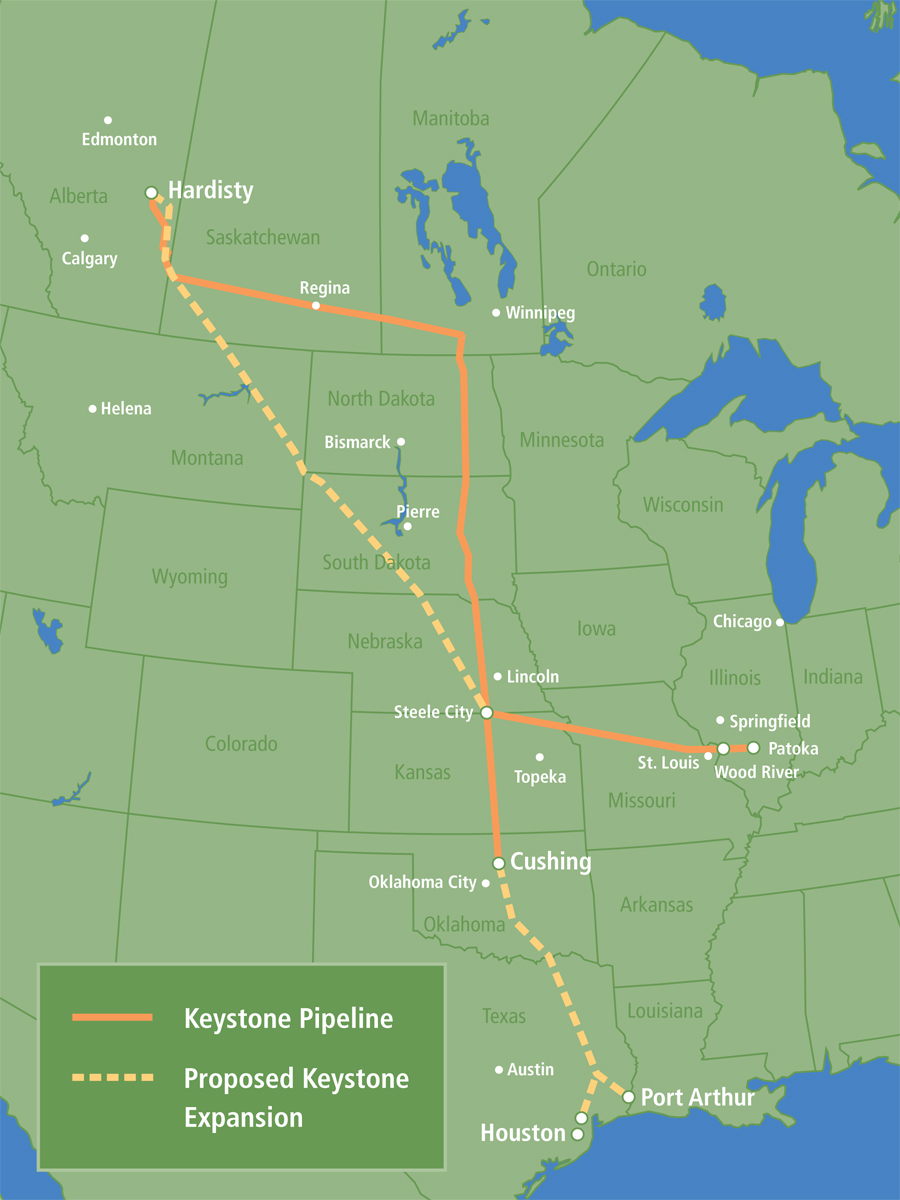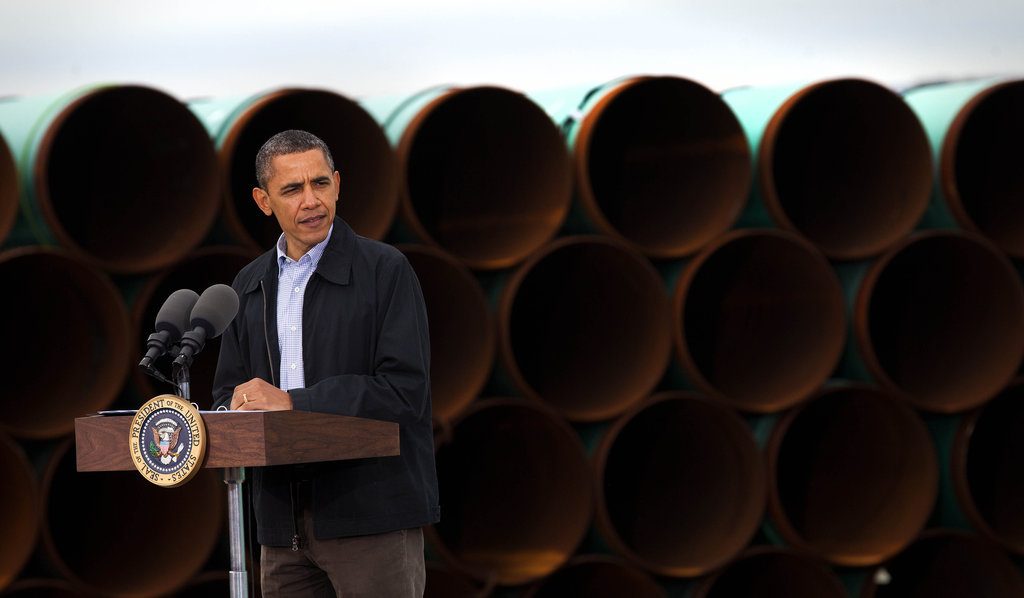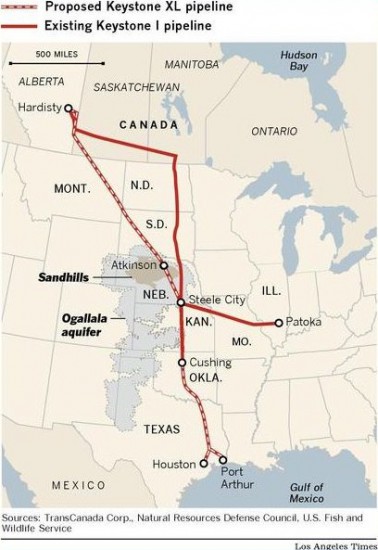
Junius Dexter
The Keystone XL Pipeline is a multinational project headed by TransCanada, with the goal of creating a direct route from the Alberta Tar Sands to the Gulf of Mexico. This project was in the center of an extensive controversy that took place in 2013-14 when the project was highly criticized by Native Americans, environmentalists, and white ranchers. In 2015, President Barack Obama made the decision to shut down the northern leg of the project due to such huge outcry from the public. With our new President Donald Trump signing an executive order approving the Keystone XL pipeline, we will most likely see construction attempted in the future. Several of the movements which stopped the pipeline before are coming back together and starting to fight the project all over again.
History of the Project
The Keystone XL Pipeline was originally a project aimed at connecting Alberta Tar Sands oil to the global oil market. The project is estimated to bring roughly 800 million more barrels a day through the U.S, to be sold on foreign markets. The northern leg of the pipeline would through Montana, South Dakota and Nebraska, to join with the existing southern leg in Oklahoma and Texas.

The debate around the Keystone XL pipeline was little more than an internal affair within the Canadian government in 2009, when it was proposed by TransCanada. On March 11th, 2010 the pipeline was approved by the National Energy Board of Canada (NEB). This decision was made after some debate around viability and possible competition with Enbridge (Osler).
Enbridge raised concerns around the Keystone XL contributing to a rise in the price per barrel as tolls for crossing the U.S border do not support Canadian interests. Enbridge does however contradict itself as it too sought to build the Alberta Clipper pipeline proposed in 2007 (see Enbridge).
The Southern Route

In 2012 Obama went to Ripley, Oklahoma, and pledged support for the Cushing MarketLink extension, which was dubbed the southern leg of the pipeline (Calmes). Obama in subsequent speeches would promote energy and and gas independence in the U.S and no mention much about the environmental impacts of the southern route that he endorsed.
In 2011 the Keystone Cushing extension pipeline was completed to delivered oil from Steele City, Nebraska to Cushing, Oklahoma (PGJ). The Keystone Pipeline had an original route which led it south from Canada to Nebraska then east to Illinois. However this and other extensions were added.

Two other extensions to the pipeline were added, creating a connection to the Gulf of Mexico (OGJ). The Houston Lateral is a connection to Houston oil refineries (Huffington Post) and Cushing MaketLink. These two extensions opened the market completely to the flow of oil from the Oklahoma to the Gulf of Mexico. The construction of the Houston lateral is still waiting completion, and the Cushing MarketLink was online in 2014. Both have been under construction since before the “Keystone XL” we refer to today, which in most people’s eyes is the northern extension.
2011 Protests and Public Awareness
The Keystone XL Pipeline was known by those who followed the political and economic scene in the U.S, however mainstream information on this topic was few and far between until the summer of 2011, when a protest was held in Washington D.C. at the White House.(Democracy Now). 2,100 people showed up for a two-week long protest, during which over 200 people walked the line and got arrested. People from all walks of life opposed the pipeline; some of the opponents from Nebraska and South Dakota were present as well as Bill Mckibben from 350.org.(Democracy Now).

In late 2011, a second round of even larger protests began totaling 10,000 people this time (Democracy Now). The media began to report Keystone XL as “one of the biggest political battle currently brewing” after this point (PBS).
While this was certainly not the first time the debate around Keystone XL had been displayed in the media, a Google search for “Keystone XL 2010” yielded few article written in 2010 (the year KXL was approved). This to me is an indication of the low awareness U.S citizens had about Keystone XL when it was first announced.
Until the protests of 2011, Keystone XL was undoubtedly less publicly known in the U.S and it was enough to sway public opinion as on January 18th, 2012 President Obama turned down TransCanada’s request for a permit (PBS).
Resistance Against the Northern Route
TransCanada reapplied to get a permit for its Northern Pipeline directly after Obama denied the first application (Democracy Now). This route was different than the first northern pipeline, however all maps of the route before and after 2012 are virtually indistinguishable. Before Obama’s 2012 decision the concern around the environment and specifically the Ogallala Aquifer were noted by those who payed close attention to the issue (Hannah).

Landowners in Nebraska were some of the first to realize that there was an issue with the pipeline proposed to go across their land. When TransCanada started asking to buy their land, many were hesitant and wanted to stay put (Bold Nebraska). Instead of backing off TransCanada instead threatened legal action to use eminent domain to acquire the land anyway (Pipe Dreams).
The state of Nebraska was in favor of the pipeline and thus at first offered little help to landowners. In fact, Governor Dave Heineman allowed TransCanada to use eminent domain through use of constitutional provision LB 1161 (Vote Smart). This use of eminent domain gave total control to the government in deciding the route of the pipeline. This would become the flagship battle for the opposition group Bold Nebraska and David Davina, an attorney who would fight to get this proposition proven unconstitutional (State of Nebraska Judicial Branch).

While the landowners were concerned primarily with losing their homes they also saw how a pipeline could disrupt the delicate ecosystems it went through.(Hannah) The Ogallala Aquifer is one of the largest sources of freshwater in the heart of the U.S today, it gives water to eight semi-arid states (Water Encyclopedia), but Keystone XL would pass directly over it (Hannah). The farm industry relies on this shallow source of water and feared a leak would contaminate it. If something like this were to happen to the Ogallala Aquifer the repercussions could be catastrophic, because if the water source for the Plains is taken away most of our agriculture is taken away too.
The Aquifer is in some places only 15 meters from the surface (Water Encyclopedia). The density of the aquifer in northern Nebraska is so great that Nebraska makes up about half of the aquifer’s reserves. With the depth of the aquifer being so minimal some are worried that contamination could be even worse in a place like Nebraska.
In September 2013 the court case Thompson v Heineman, reversed the provision LB 1161, and the landowners of Nebraska were victorious in getting the provision proven unconstitutional. However this was not the end of the battle. Most of the landowners were confident that they were protected by the media and the President (Think Progress).

“We remain confident the President will stand with farmers, ranchers, and tribal communities over a foreign oil company that wants to get tar sands to the export market.”– Jane Kleeb (Bold Nebraska)
Effects on Native Communities
The struggles of the Native peoples in Nebraska and South Dakota against Keystone XL has similar roots to the objections of the white ranchers. The Lakota Sioux tribes of South Dakota asserted that because of the Fort Laramie Treaties of 1851 and 1868, the government could not allow for a pipeline to be built on their treaty lands without their consent.

The Keystone XL route would not go directly over any current, however the proximity of the pipeline to the reservations impacts their ecosystems. The Sioux are using the argument of the 1868 treaty to defend their claim to the land the TransCanada wishes to use.
The Cowboy Indian Alliance is not an official organization but it is a movement born out of necessity. This explains the contradictory nature of the alliance between two groups who historically have been at war. The hatred of the past is not strong enough to blind people to the present. The Keystone XL pipeline affected both of these communities sharing a home of the Plains. The Ogallala Aquifer binds these people through the water. In April 2014, the first Cowboy Indian Alliance march was held in Washington D.C. (National Geographic). The goals of the march were to both show the nation the alliance, and announce a call to action known as “Reject and Protect” (Bold Nebraska).

Defeat of Keystone XL Under Obama
In November 2014 a bill to take power away from the State Department in the decisionmaking process of approving Keystone XL was almost forced through Congress. The opposition had the minority and the bill did not pass due to one vote (Mother Jones). The final count was 59 “yes,” but 60 “yes” votes were needed to pass the legislation that would have tried to push through KXL. Obama who up to this point was politically opposed to the pipeline, as it had become a 100% partisan issue, was getting sick of KXL as it had been around his entire administration.
The protests and movements around Keystone XL had shed new light on the issue that was once well hidden. This along with the completion of the southern route in 2014 gave Obama little reason to resist rejecting the northern portion Keystone XL.
On November 6, 2015 President Barack Obama would reject the Keystone XL but unlike he had done in 2012, he was rejecting it due to environmental impacts (Democracy Now). This was the end of the Keystone XL battle under the Obama Administration and was a time of rest for all of those who had put the time and effort into defeating it.
Since the Keystone Rejection
In 2016 a lawsuit by TransCanada against the Obama Administration, claimed that his rejection of Keystone XL was a violation of the North American Free Trade Agreement (Washington Post). TransCanada was requesting that the U.S pay it billion dollars because of wasted time, money and effort on the blocked northern route. Although this suit was threatened in January 2016 TransCanada moved forward with the official arbitration process on the 25, June (Huffington Post). The process was most likely underway when Donald Trump stepped into office.

What is known is that on January 24, 2017 Donald Trump signed an executive order inviting TransCanada to reapply for its Keystone XL permit (CNN). Trump has been using pro-working class rhetoric to say the pipeline would bring new jobs and boost U.S energy independence. While the White House has given a go-ahead to TransCanada, on a state level in Nebraska TransCanada has sent in an application with Public Service Commission (Bold Nebraska). This process can take up to a year and a minimum of eight months. Members of Bold Nebraska are now fighting to make sure the Commission denies the permit application; there is no pipeline route yet in the state.
A Pew Research Center poll of around 1,500 adults found that 42% of Americans support the Keystone XL pipeline and 48% do not. (Pew Research Center) This is a major switch from the beginning of this debate in 2011 when around 60% of the population supported Keystone XL. The amount of awareness raised over this pipeline was astonishing and has really turned it into a political dead horse. The fight over Keystone XL is not over as several other states are involved in the construction and thus parts of the northern route could be completed before the others. Only time will tell as this story is still unfolding.

Sources
Bold Nebraska (2017).
Calmes, Jackie (2012, March 22) In Oklahoma, Obama Declares Pipeline Support. New York Times.
Canadian Press (2016, June 27). TransCanada makes good on NAFTA lawsuit against U.S. Huffington Post.
Democracy Now (2011, November 7) 10,000 Surround White House to Protest Keystone XL
Democracy Now (2012, January 19). Obama rejects Keystone Pipeline.
Democracy Now (2015, November 6) .President Obama Rejects Keystone XL.
Goodman, Amy. (2011, August 24th) D.C Protests that make big oil quake. Democracy Now.
Google (2017, February 22) “keystone xl 2010” search results
Hannah, Daryl (2016, March 24). Pipe Dreams .
Horn, Steve (2013, December 20) Keystone XL fork in the road: Houston lateral Pipeline. Huffington Post Blog
Jones, Athena. Diamond, Jeremy. Krieg, Gregory (2017, January 24) Trump advances controversial oil Pipeline with executive order. CNN.
Lee, Brianna. (2011, November 7). 5 Things you need to know about the Keystone XL pipeline. PBS
McDonnell, Tim (2014, November 17). The senate just voted not to approve Keystone XL. Mother Jones.
National Energy Board of Canada (2009-2013) Archived – TransCanada Keystone Pipeline
Osler (2010, March 8). NEB Approves Keystone XL Pipeline Project.
Pipeline and Gas Journal (2011, February). Keystone’s Cushing Pipeline Extension Begins Deliveries to Oklahoma .
RT (2016, April 7) Keystone Pipeline Leaked 16,000 Gallons of Oil in South Dakota Field.
Smith, Christopher (2011, November 18) Cushing MarketLink Oil pipeline moving forward. Oil and Gas Journal.
Smith, Heather (2015, January 9) Here’s the deal with that Nebraska Keystone court ruling. Grist.
State of Nebraska Judicial Branch (2014, September 5) Thompson v Heineman.
Suls, Rob (2017, February 21) Public divided over Keystone Xl. Pew Research Cente.
Tucker, Todd (2016, January 8) TransCanada is suing the U.S. over Obama’s rejection of Keystone XL. Washington Post.
Valentine, Katie (2015, January 9). Nebraska Supreme Court Ruling Upholds Keystone XL Pipeline Route. Think Progress.
Vote Smart (2017) LB 1161.
Ward, Brian (2014, March 19) Coming together over Keystone XL. Socialist Worker.
Water Encyclopedia (2017). Ogallala Aquifer.